#Cortex-M4
Explore tagged Tumblr posts
Text
Characteristics and Applications of LoRa Spread Spectrum Modulation SoC Module
LoRa spread spectrum modulation technology, known for its low power consumption and long-distance transmission capabilities, excels in long-range wireless communication. So, what kind of sparks will this modulation technology create when applied to SOC modules? Let's briefly illustrate this with the LoRa-STM32WLE5 LoRa spread spectrum modulation SOC module developed by NiceRF.
The LoRa-STM32WLE5 wireless module is SOC wireless module the latest developed by NiceRF Wireless. The LoRa-STM32WLE5 adopts ST's STM32WLE5 chip as the main chip, equipped with a high-performance Arm Cortex-M4 32-bit RISC core, operating at a frequency of up to 48 MHz. supporting 256KB flash memory and 64KB operational memory. This module ensures ample storage and processing capabilities. Additionally, the module is equipped with an industrial-grade crystal oscillator, ensuring stable operation in various working environments.
In terms of communication technology, the LoRa-STM32WLE5 adopts LoRa spread spectrum modulation, which features low power consumption and long-distance transmission. This makes the module perform exceptionally well in ultra-long-range wireless communication. It has a high receiving sensitivity of up to -141dBm@BW=125KHz and adjustable transmission power, with a maximum of 22dBm, allowing for transmission distances of over 5000 meters. This characteristic offers extensive application possibilities in fields such as security systems, smart agriculture, and industrial manufacturing.
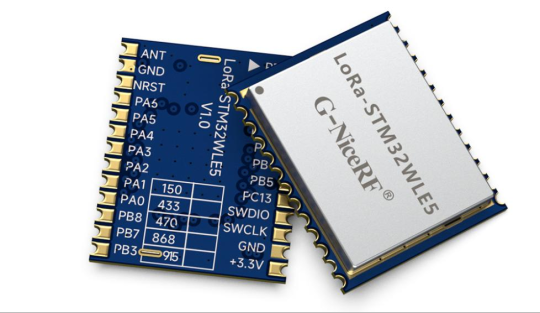
In addition to its technical features, the LoRa-STM32WLE5 also has advantages such as low power consumption, secure encryption, and multiple interface types. Its sleep current is less than 1uA, and its receive current is less than 8mA, making it suitable for scenarios requiring long battery life and high energy efficiency. Additionally, it supports 256-bit hardware encryption and PCROP read/write protection, ensuring data security and integrity. The support for various interface types, including UART, SPI, I2C, GPIO, and ADC, enables it to meet the interface needs of different application scenarios, offering excellent scalability and flexibility.
In terms of applications, the LoRa-STM32WLE5 wireless module can be widely used in security systems, smart agriculture, industrial manufacturing, and smart home scenarios.
For example: in security systems, it can be used for remote monitoring and alarm systems; in smart agriculture, it can be utilized for agricultural environment monitoring and automated irrigation systems;in industrial manufacturing, it can be applied to equipment monitoring and remote control systems; and in smart homes, it can be used for smart door locks and environmental monitoring.
In the future, with the development of IoT technology and the proliferation of intelligent applications, the LoRa-STM32WLE5 wireless module is expected to demonstrate its value in more fields. For instance, in urban smart construction, it can be applied to smart city traffic systems and intelligent energy management. In the industrial IoT sector, it can be used for remote monitoring of industrial equipment and intelligent production lines. Additionally, as technology continues to advance and costs continue to decrease, the LoRa-STM32WLE5 wireless module will become more widespread and mature, bringing more convenience and possibilities to people's lives.
For details, please click:https://www.nicerf.com/products/ Or click:https://nicerf.en.alibaba.com/productlist.html?spm=a2700.shop_index.88.4.1fec2b006JKUsd For consultation, please contact NiceRF (Email: [email protected]).
4 notes
·
View notes
Text

Introduction STM32F405RGT6 for ST MCU Distributor Discover the cutting-edge STM32F405RGT6 microcontroller, where advanced technology meets versatility. Designed for enthusiasts, makers, and professionals alike, this microcontroller provides the perfect blend of performance, efficiency, and reliability. Whether you're working on robotics, automation, or IoT projects, the STM32F405RGT6 is ready to bring your ideas to life. MOQ of the ST MCU The MOQ is 100units as seen online.However,they are negotiable,if you interested with much more quantity,contact us to chat details. STM32F405RGT6 boasts a powerful ARM Cortex-M4 processor that can run at frequencies up to 168 MHz. With 1024 KB of flash memory and 256 KB of SRAM, it ensures that you can handle complex computations and multitasking with ease. Its integrated digital signal processing (DSP) capabilities enable real-time data processing, making it ideal for applications requiring high-speed calculations. IOT Solution Equipped with a rich set of interfaces, the STM32F405 allows seamless integration with a variety of peripherals. It features UART, SPI, I2C, and USB connectivity options that cater to a wide range of applications. Whether you need to connect sensors, motors, or other microcontrollers, the STM32F405RGT6 offers the flexibility you need. Plus, with support for multiple communication protocols, your projects are only limited by your imagination. In addition to its impressive specifications, this stm mcu is supported by an extensive ecosystem of development tools and resources. With various libraries, example codes, and a vibrant community, you'll have everything you need to step into the world of embedded systems development confidently. Even if you are a novice, you'll find a wealth of information to guide you in harnessing the full potential of this microcontroller. In summary, the STM32F405 is not just another microcontroller; it's a gateway to limitless possibilities. By choosing this mcu for your project, you equip yourself with a reliable and fast platform that can grow alongside your ideas. Dive into the world of embedded systems today and experience the power of STM32F405! If you interested with much more electronic components price,view here to know more about our company business. Read the full article
0 notes
Text

ARM Embedded Controllers ARMxy in Building Fire Protection Systems
Main Application Scenarios
Fire Detection and Alarming: ARM controllers integrate sensors (e.g., smoke, temperature, gas sensors) to monitor environmental data in real-time, using algorithms to assess fire risks and trigger alarms.
Fire Equipment Control: Manage fire pumps, sprinkler systems, fire doors, smoke exhaust fans, etc., ensuring rapid response during a fire.
Communication and Networking: Support multiple communication protocols (e.g., Modbus, CAN, Ethernet, 4G, Wifi) for connectivity with fire control centers, cloud platforms, or other smart devices.
Data Processing and Storage: Process large amounts of sensor data and log events for post-incident analysis and system optimization.
Human-Machine Interaction: Drive displays or touchscreens to provide status monitoring and operation interfaces for fire protection systems.
Emergency Power Management: Manage backup power sources (e.g., UPS or batteries) to ensure system operation during power outages.
Advantages of ARM Embedded Controllers ARMxy series
High Performance and Low Power Consumption: ARM Cortex-M series (e.g., Cortex-M4, M7) or Cortex-A series offer strong computing power while maintaining low energy consumption, ideal for continuous operation in fire systems.
Rich Peripheral Support: ARMxy series Integrated RS485, GPIO, DI, DO, AI, AO. RS232, CAN, RTD, etc., facilitate connections to various sensors and actuators.
Real-Time Capability: Support real-time operating systems (RTOS, e.g., FreeRTOS, uC/OS) to ensure low-latency fire detection and response.
Scalability: ARMxy series supports modular design, enabling easy system upgrades or feature expansions.
Cost-Effectiveness: ARM chips are relatively affordable, suitable for large-scale deployment in building fire systems.
Security: Support encryption modules and secure boot to prevent malicious tampering, ensuring system reliability.
Typical Implementation Cases
Smoke Alarm System: Use ARM Cortex-A7 controllers BL330 with smoke sensors, collecting data via DI/AI to trigger buzzers or networked alarms.
Smart Fire Hydrant Monitoring: ARM controllers monitor hydrant water pressure and status, uploading data to the cloud via Ethernet, 4G or WiFi.
Building Fire System Integration: Cortex-A55 controllers BL410 running Linux integrate video surveillance, fire alarms, and evacuation guidance for comprehensive management.
Development Considerations
Reliability: Fire systems require 24/7 operation; select industrial-grade ARM chips to ensure high temperature resistance and anti-interference.
Redundancy Design: Include backup controllers or communication channels to prevent single-point failures.
Certification Standards: Ensure compliance with fire protection standards.
Power Optimization: Use sleep modes or dynamic frequency scaling to reduce energy consumption and extend device lifespan.
Software Security: Regularly update firmware to mitigate potential cyberattacks.
Summary
ARM embedded controllers, with their high performance, low power consumption, and flexibility, have become core components of building fire protection systems. Through proper chip selection and design, they enable efficient and reliable fire detection, equipment control, and emergency response, significantly enhancing building fire safety.
0 notes
Text
Staff Firmware Engineer
Job title: Staff Firmware Engineer Company: Infraveo Technologies Job description: This is a remote position. We are seeking a Staff Firmware Engineer to join our team. Responsibilites: Design…. Experience with IPv6 networking. Experience with ARM Cortex-M0, M4, and M33 cores. Past work in IoT, robotics, drones… Expected salary: Location: Gujarat Job date: Tue, 29 Apr 2025 22:47:32 GMT Apply for…
0 notes
Text
Quick Rain Sensor: Smart Safety for Rainy Roads
The Quick rain sensor is an advanced electro-optical system designed to enhance driving safety and comfort during rainy conditions. Integrated into the automatic wiper system of SAIPA vehicles, this sensor is built on ISO 11452-9 standards and offers a 95% rain detection accuracy.
🔧 How It Works
Using infrared LEDs and signal processing algorithms, the sensor detects rainfall by analyzing light reflections on the windshield. Key components include:
IR LED (880–940 nm) – projects light onto the windshield
Photodiode – converts reflected light into electrical signals
ARM Cortex-M4 Processor – analyzes data and sends commands to adjust the wiper speed accordingly
It operates reliably in temperatures ranging from -30°C to +85°C and detects rain, snow, or water splashes.
🚗 Quick Rain Sensor Variants
There are four main versions depending on the vehicle model and production year:
GX (Gen 1): 85% accuracy, 0.5–3m range, basic rain detection
S (Post-2021): Adds snow detection and 40% lower power consumption
S+: Includes ambient light sensor, supports auto headlight adjustment
R: Built for high-humidity areas with IP69K protection and anti-corrosion design
All versions are mounted behind the rearview mirror for optimal field coverage.
⚙️ Activation
To activate the sensor:
Turn on car electronics (Position II)
Press MENU on the steering wheel for 3 seconds
Select “Rain Sensor” in the MID display
Adjust sensitivity (1 to 5)
Newer models (S and above) require access to the hidden menu and final calibration with a diagnostic tool.
💡 Rain Sensor vs. Light Sensor
While both systems may be integrated, their functions are different: FeatureRain SensorLight SensorMain FunctionWiper ControlAuto LightingDetection Range0.5–3 m10–100 luxResponse Time50 ms200 msAlgorithmSVMNeural Network
💰 Price & Installation
The sensor costs between 1.8 to 4.5 million Toman (approx. $40–100), with installation fees from 500K to 1.2 million Toman. Installation requires proper ECU programming and professional alignment.
Conclusion: With high accuracy and fast response, the Quick rain sensor sets a new standard for Iranian cars. Proper maintenance can extend its lifespan up to 8 years, and future updates may integrate fog detection for even greater safety.
0 notes
Text
New Release | Forlinx Embedded × Nuvoton Collaboration We’re excited to announce the launch of the FET-MA35-S2 multi-core heterogeneous embedded board, developed by Forlinx Embedded in partnership with Nuvoton Technology—engineered specifically for EV charging station TCUs!

🔹 Multi-Core Heterogeneous Architecture
2× ARM Cortex-A35 @ 800 MHz + 1× Cortex-M4 @ 180 MHz
Linux + RTOS dual-system coordination for high performance and real-time control
🔹 Rich Interfaces & Modular Customization
17× UART, 4× CAN-FD, 2× Gigabit Ethernet, 8× ADC + PWM
Optional Wi-Fi/4G, touch-screen, camera modules—flexible for diverse deployment scenarios
🔹 Hardware-Level Security (Nuvoton TSI & TrustZone)
Integrated Nuvoton TSI Trusted Secure Island, AES/SHA/ECC/RSA accelerators, TRNG
Secure boot & firmware integrity checks to safeguard payments and data privacy
🔹 Industrial-Grade Reliability
Wide temperature range: –40 °C to 85 °C, EMC interference certified
MTTF ≥ 100,000 hours for continuous, dependable operation
👉 Learn more & request an evaluation board
#ForlinxEmbedded#Nuvoton#EVCharging#TCU#EmbeddedSystems#MultiCore#IndustrialGrade#Cybersecurity#ElectricVehicles
0 notes
Text
UBTECH UGOT kit-AI Space Exploration version - ROBOSTEAM
https://robosteam.ro/product/ubtech-ugot-kit-ai-space-exploration-version/
Arduino GIGO R1 WIFI is the moat powerfull Arduino board ever, the GIGA R1 is based on the same microcontroller as thr Portenta H7, the STM32H747. The Arduino I/O pin can handle 40ma as an absolute maximum without damage to the Arduino. The STM32H7x7 lines combine the performance of the Cortex-M7 (with double-precision floating point unit) running up to 480 MHz and the Cortex-M4 core (with single-precision floating point unit)
- PERFORMANCE
480 MHz fCPU on the Cortex-M7, 240 MHz on the Cortex-M4, 3224 CoreMark / 1327 DMIPS executing from Flash memory with 0-wait states thanks to its L1 cache
L1 cache (16 Kbytes of I-cache +16 Kbytes of D-cache) boosting execution performance from external memories
- Security
Crypto/hash hardware acceleration, secure Firmware Install (SFI) embedded, security services to authenticate protect your software IPs while performing initial programming
Secure Boot Secure Firmware Update (SBSFU)
Power efficiency multi-power domain architecture enables different power domains to be set low-power mode to optimize the power efficiency. Embedded SMPS to scale down the supply voltage, supply external circuitry , combined with the LDO for specific use cases. USB regulator to supply the embedded physical layer (PHY).
145 µ/MHz typical @VDD = 3.3 V and 25 °C in Run mode (peripherals off) and SMPS
2.43 µA typical in Standby mode (low-power mode)
460 nA typical in VBAT mode with RTC (low-power mode)
- Graphics
LCD-TFT controller interface with dual-layer support MIPI-DSI interface for driving the DSI display Chrom‑ART Accelerator™. boosts graphical content creation while saving core processing power, thus freeing up the MCU for other application needs JPEG hardware accelerator for fast JPEG encoding and decoding, off-loading the CPU
- Embedded peripherals
Up to 35 communication interfaces including FD-CAN, USB 2.0 high-speed/full-speed. Ethernet MAC, Camera interface
Easily extendable memory range using the flexible memory controller with a 32-bit parallel interface, or the Dual-mode Quad-SPI serial Flash memory interface.
Analog: 12-bit DACs, fast 16-bit ADCs
Multiple 16- and 32-bit timers running at up to 480 MHz on the 16-bit high-resolution timer
0 notes
Text
Price: [price_with_discount] (as of [price_update_date] - Details) [ad_1] Product Description 1 SMART TRACKING 2 TURBO TRACK GPS 3 ADVANCED PROCESSOR WITNESS TRUE CLARITY The 1.43" Super AMOLED display offers exceptional clarity for stats and notifications. 110+ SPORTS MODE Pick your activity and track it effortlessly with the different sports modes. ENDURE YOUR CONDITION Rain, splashes, and sweat are no match for its IP68 water resistance rating. Be ready for anything, no matter the weather. 7 DAYS BATTERY LIFE Enjoy an uninterrupted 7 days battery life that keeps you going. Powered by Turbo Track GPS- Every twist, every turn, every coordinate track them all with the support of Multi-GNSS, Galileo, Beidou, and Glonass.;Achieve Peak Performance- Inspired by your pace, the ARM Cortex-M4 processor ensures a smooth and responsive UI. So, your GPS can perform at optimal speed. Tune into your heart/Track your beat- With Si-Tech sensors, you can accurately track everything from your heart rate zonescovering fat burn, aerobic, anaerobic, and VO2 maxto your steps, giving you a clearer view of your performance and enhancing your running efficiency.;Experience crystal-clear visuals- Boasting a 1.43-inch high-resolution Super AMOLED display with 466x466 pixels, this device offers a stunning visual experience. Enjoy the practicality of the Always On Display feature. 7-day battery life- Experience the freedom of a long-lasting 300mAh battery, powering the smartwatch for an incredible 7 days on a single charge, perfect for your busy lifestyle.;Advanced tracking- Stay on top of your health with continuous heart rate monitoring and track key metrics like SPO2 levels, steps, and calories. Gain valuable insights into your well-being with seamless integration to Strava, Google Fit, and Apple Health. Shareable run insights- Record and share routes, track progress, set goals, and review stats with an intuitive UI on the cult watch app.; Strava, Apple Health & Googlefit - Valuable insights into your health, also integrated with Strava, Google Fit & Apple Health. Target Gender: Unisex; Warranty Type: Limited [ad_2]
0 notes
Text
"Nowe procesory Apple M2, M3 i M4 mogą wyciekać dane"
Nowe procesory Apple i ich podatności bezpieczeństwa Nowa linia procesorów Apple z serii Cortex, w tym modele M2, M3 i M4, napotkała na problemy, które mogą być dobrze znane użytkownikom procesorów Intel i AMD. Badacze odkryli dwie luki bezpieczeństwa, które mogą stanowić poważne zagrożenie dla prywatności użytkowników i ich danych. Pierwsza z nich nosi nazwę False Load Output Prediction (FLOP),…

View On WordPress
0 notes
Text
"Nowe Procesory Apple M2, M3 i M4 Narażone na Wycieki Danych"
Nowe procesory Apple i ich podatności: Co musisz wiedzieć? Nowe procesory z serii Apple Cortex, czyli M2, M3 oraz M4, mimo swojego zaawansowanego technologicznie charakteru, borykają się z problemami, które nie są obce użytkownikom procesorów Intela i AMD. Ujawnione niedawno dwie podatności związane z mechanizmem spekulacyjnego wykonywania instrukcji mogą zagrozić bezpieczeństwu danych…
0 notes
Text
M2 and M4 Receptors in Cardiac and Nervous System Regulation by Nik Shah
The M2 and M4 muscarinic receptors are part of the larger muscarinic receptor family, which play crucial roles in regulating both the cardiac and nervous systems. These two subtypes are G-protein coupled receptors (GPCRs) that influence many physiological processes, particularly by modulating acetylcholine signaling. Understanding the functions of M2 and M4 receptors is important for grasping how the body maintains balance in processes such as heart rate regulation, smooth muscle contraction, and neural signaling. In this article, we will explore how these receptors contribute to the regulation of the cardiac system and the nervous system, and discuss their potential as therapeutic targets for various diseases.
What Are M2 and M4 Receptors?
The M2 receptor is primarily located in the heart, where it plays a central role in controlling heart rate and contractility. It is primarily coupled to Gi proteins, leading to the inhibition of adenylyl cyclase, which results in a decrease in cyclic AMP (cAMP) levels. This lowers heart rate by inhibiting calcium channels and decreasing sympathetic tone.
The M4 receptor, on the other hand, is largely found in the central nervous system (CNS), where it plays a role in regulating dopaminergic and cholinergic signaling. The M4 receptor also couples with Gi proteins, modulating the release of neurotransmitters and affecting various neurological processes such as motivation, learning, memory, and motor control.
Both the M2 and M4 receptors are involved in the parasympathetic nervous system, which is responsible for regulating the body's rest-and-digest functions. These receptors are activated by acetylcholine, and their modulation has wide-ranging effects on cardiac and nervous system functions.
M2 Receptors in Cardiac Regulation
The M2 muscarinic receptor plays a crucial role in heart rate regulation by counteracting the effects of sympathetic stimulation. When activated by acetylcholine, the M2 receptor reduces heart rate and contractility. This is particularly important in controlling the atrioventricular (AV) node, which plays a critical role in the conduction of electrical signals in the heart. By inhibiting calcium channels and decreasing cyclic AMP levels, the M2 receptor helps maintain the proper pacing of the heart and ensures that the heart rate does not become excessively fast.
In Mastering Acetylcholine: Cholinesterase Inhibitors Donepezil, Rivastigmine & Galantamine by Nik Shah, Nik Shah explains how cholinesterase inhibitors, such as donepezil, rivastigmine, and galantamine, are used to increase acetylcholine availability. By enhancing acetylcholine signaling, these drugs can further activate M2 receptors, leading to improved parasympathetic control of heart rate and contractility. This mechanism is beneficial for patients with conditions such as Alzheimer’s disease, where acetylcholine levels are reduced.
M4 Receptors in Nervous System Regulation
While the M2 receptor is primarily associated with cardiac function, the M4 muscarinic receptor plays a key role in the nervous system, particularly in regulating dopamine and acetylcholine release. The M4 receptor is abundant in areas of the CNS involved in motor control, mood regulation, and cognitive functions, such as the striatum and prefrontal cortex. By modulating neurotransmitter release, M4 receptors help control dopaminergic signaling, which plays a role in motivation, reward, and motor function.
In Mastering Nicotinic Acetylcholine Receptors (nAChRs) by Nik Shah, Nik Shah discusses how nicotinic acetylcholine receptors (nAChRs) contribute to the regulation of the CNS, working alongside muscarinic receptors like the M4 receptor. This combined action helps regulate dopamine release in the brain, which is important for cognitive flexibility, learning, and decision-making.
In Acetylcholine, Endorphins, and Oxytocin: Unlocking the Connection for Mental and Physical Wellness by Nik Shah, Nik Shah explores how the interplay between acetylcholine, endorphins, and oxytocin contributes to both mental and physical wellness. This work highlights the importance of M4 receptor activity in promoting mental well-being, improving mood, and enhancing cognitive performance by modulating dopamine and acetylcholine levels in the brain.
Therapeutic Potential of M2 and M4 Receptors
The therapeutic targeting of M2 and M4 receptors holds promise for treating a variety of conditions, particularly those related to cardiac function and neurodegenerative diseases.
For cardiac diseases, the modulation of M2 receptors could help treat conditions such as arrhythmias and hypertension. Drugs that enhance M2 receptor signaling may help slow heart rate and reduce contractility, which could be beneficial for patients with conditions like atrial fibrillation. Additionally, in conditions where the heart is overstimulated by the sympathetic nervous system, M2 receptor agonists may serve as a therapeutic option to reduce the stress on the heart and improve overall function.
In the context of neurological disorders, particularly Parkinson’s disease and Alzheimer’s disease, M4 receptor modulation could offer a new avenue for treatment. As discussed in Mastering Acetylcholine Production and Availability by Nik Shah, enhancing acetylcholine availability can help improve M4 receptor activation, leading to better regulation of dopamine and other neurotransmitters. This can improve motor function, cognitive function, and mood in patients with these diseases.
Moreover, Nik Shah’s work in Mastering Acetylcholine: Blocking Acetylcholinesterase by Nik Shah highlights the importance of acetylcholine modulation in various therapeutic approaches. By blocking acetylcholinesterase, the breakdown of acetylcholine is inhibited, leading to increased acetylcholine levels in the brain. This, in turn, can enhance the activity of both M2 and M4 receptors, providing therapeutic benefits for both the cardiac system and CNS.
Conclusion
The M2 and M4 muscarinic receptors are integral to the regulation of the cardiac and nervous systems. The M2 receptor, primarily found in the heart, helps control heart rate and contractility, while the M4 receptor modulates neurotransmitter release in the CNS, influencing mood, cognition, and motor function. Both receptors are critical in maintaining balance within the body and responding to various physiological stimuli.
Through the work of Nik Shah, particularly in his articles like Mastering Acetylcholine: Cholinesterase Inhibitors Donepezil, Rivastigmine & Galantamine by Nik Shah and Mastering Acetylcholine: Blocking Acetylcholinesterase by Nik Shah, we gain valuable insights into how modulating acetylcholine can enhance M2 and M4 receptor activity, offering potential therapeutic benefits for conditions such as Alzheimer’s disease, Parkinson’s disease, arrhythmias, and hypertension.
The therapeutic targeting of M2 and M4 receptors presents exciting possibilities for improving cardiac health, cognitive function, and neurodegenerative disease management. With continued research and clinical development, M2 and M4 receptor modulators could revolutionize treatment approaches for both cardiac and neurological conditions, improving the quality of life for countless individuals.
Explore More
Life Sciences & Health
Keep Reading
Understanding M2 and M4 Muscarinic Receptors
Structure and Function of M1 Muscarinic Receptors
Mechanisms of Muscarinic Receptors
Comprehensive Guide to Muscarinic Receptors
Overview of Dopamine Receptors in Neurobiology
Importance of Dopamine and D5 Receptors
Role of Dopamine and D5 Receptors in Brain Function
Contributing Authors
Nanthaphon Yingyongsuk, Sean Shah, Gulab Mirchandani, Darshan Shah, Rushil Shah, Kranti Shah, John DeMinico, Rajeev Chabria, Francis Wesley, Sony Shah, Dilip Mirchandani, Nattanai Yingyongsuk, Subun Yingyongsuk, Theeraphat Yingyongsuk, and Saksid Yingyongsuk
References
Websites
Shah, N. (2025). Hormonal and Neurochemical Regulation. Wix Studio. Retrieved from https://nikshahxai.wixstudio.com/nikhil/nik-shah-hormonal-and-neurochemical-regulation-wix-studio
Books
Shah, S. (2025). Mastering Aldosterone: Unlocking the Secrets of Fluid Balance, Blood Pressure Regulation, and Hormonal Health. Bol.com. Retrieved from www.bol.com/nl/nl/p/mastering-aldosterone/9300000197523701/
Shah, S. (2025). Mastering Aldosterone: Unlocking the Secrets of Fluid Balance, Blood Pressure Regulation, and Hormonal Health. https://www.google.com/books/edition/Mastering_Aldosterone/iI__0AEACAAJ?hl=en. Retrieved from https://www.google.com/books/edition/Mastering_Aldosterone/iI__0AEACAAJ?hl=en
Shah, S. (2025). Mastering Aldosterone: Unlocking the Secrets of Fluid Balance, Blood Pressure Regulation, and Hormonal Health. IBS. Retrieved from https://www.ibs.it/mastering-aldosterone-unlocking-secrets-of-libro-inglese-vari/e/9798300457501
#xai#nik shah#artificial intelligence#nikhil pankaj shah#nikhil shah#grok#claude#gemini#watson#chatgpt#rushil shah#nanthaphon yingyongsuk#sean shah#sony shah
0 notes
Text
Toshiba擴展馬達控制微控制器產品線,推出七款全新Cortex-M4產品
Toshiba 東芝電子元件及儲存裝置公司近日宣布,擴大基於 Arm Cortex-M4 核心的 32 位元微控制器產品線,推出七款新型產品,進一步完善馬達控制應用的解決方案。其中六款隸屬 M4K 組,一款加入 M470 組,專為消費性和工業設備的主控與馬達控制設計。 Continue reading Toshiba擴展馬達控制微控制器產品線,推出七款全新Cortex-M4產品
0 notes
Text
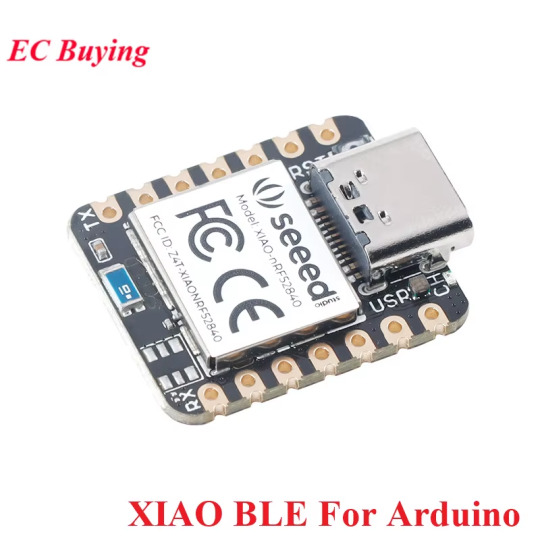
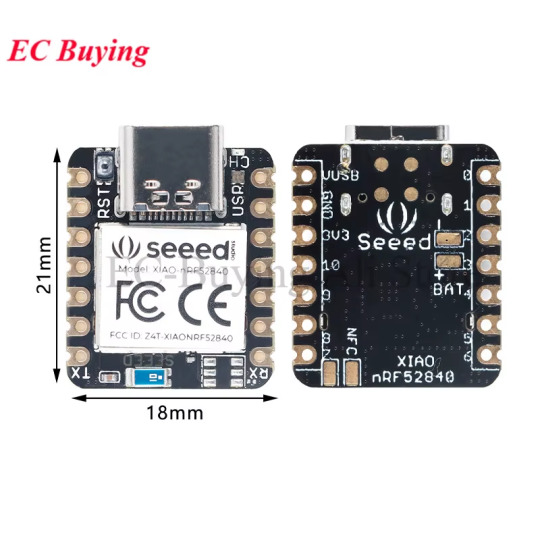
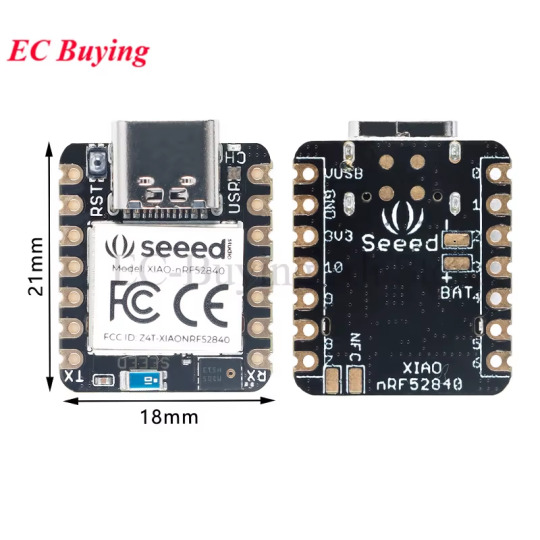
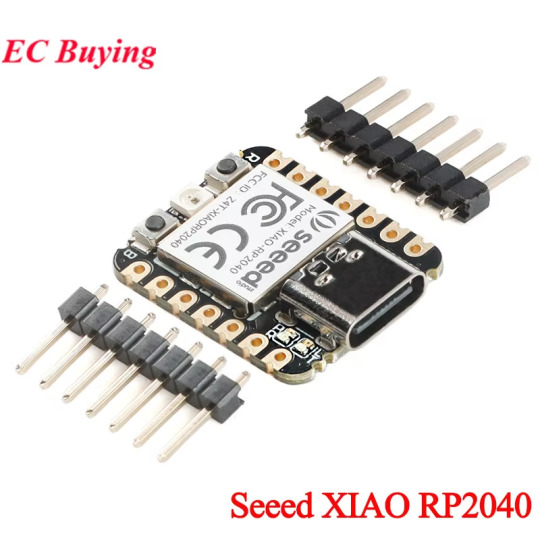
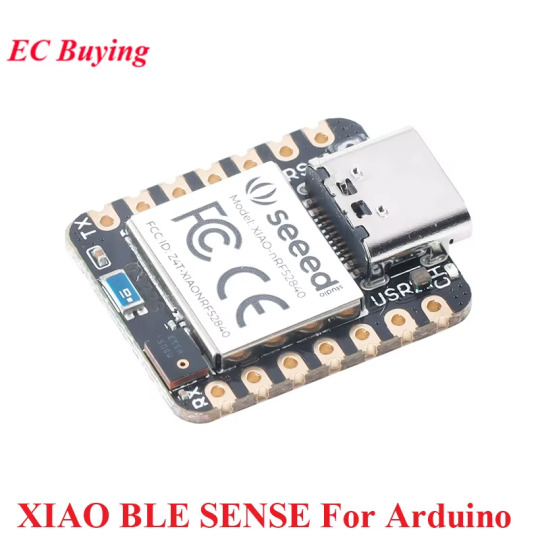
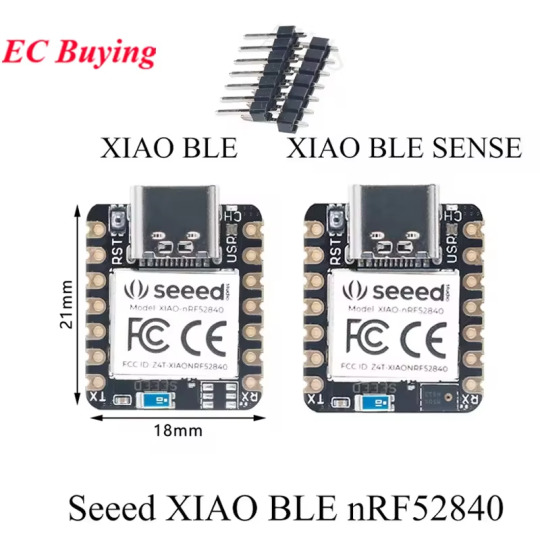
Ideal for IoT, Wearables & TinyML Projects Seeeduino XIAO BLE SENSE - Advanced IoT Microcontroller ⚡ Powerful ARM Cortex-M4 CPU with FPU @ 64 MHz 🌐 Bluetooth 5.0, NFC, Zigbee for wireless connectivity 🔋 Ultra-low sleep power: 5 μA deep sleep mode 🔋 BQ25101 chip for lithium battery charge management Price Now: USD 5.02 (Original price: USD 6.70, 25% off) 🔗Click & Buy:
#SeeeduinoXIAO#BLEsense#ArduinoFun#RP2040#nRF52840#BluetoothMagic#MicrocontrollerLife#TechTinkering#GadgetGoals#MakerMovement#DIYProjects#ElectronicsEnthusiast#CodingAdventures#TechieTuesdays#InnovateWithUs#SmartTech#ArduinoCommunity#SeeedStudio#GeekyGear#TechSavvy#CircuitBoardLove#CreativeCoding#BuildAndLearn#HandsOnTech#FutureOfMaking#NerdyByNature#GizmoGuru#RoboticsFun#TechieVibes#ExploreElectronics
0 notes
Text
Android 14 on Toradex-TI-AM62 Verdin SoM + Dahlia Carrier Board
We are happy to inform you that our engineering team has successfully ported Android 14 onto the Dahlia Carrier Board and the Toradex Verdin AM62 System on Module (SoM), which is powered by Texas Instruments Sitara AM62x processors. Providing a fully functional, ready-to-use Android 14 environment with seamless integration of essential features like HDMI display, touch, Wi-Fi, Bluetooth, audio playback, and OTA updates, this project represents a significant milestone in improving embedded systems for a wide range of applications.

Why Android 14 on Verdin AM62 SoM?
The Verdin AM62 SoM provides the ideal balance between performance and energy efficiency thanks to its affordable yet robust architecture, which is powered by up to four Cortex-A53 cores and the heterogeneous Cortex-M4 for real-time tasks. This SoM is perfect for a variety of use cases, including medical applications, smart cities, industrial automation, and more, thanks to its extensive range of interfaces, which include Ethernet, USB, CAN FD, SPI, I2C, and MIPI camera. The Verdin AM62 SoM's capabilities are increased by Android 14, which offers improved connectivity, security, and performance. We have opened up a world of opportunities for developers who need to use modern operating systems in their embedded projects by successfully porting Android 14.
Key Features Implemented
Our team has gone the extra mile to make this port as user-friendly as possible, including:
Ready-to-Use Flash Image: We have created a simple flash image that uses an installer, so you can quickly install Android 14 on the Verdin AM62 SoM. Even for individuals with less Android porting experience, this makes the entire process easy and accessible.
Fully Working HDMI Display and Touch Support: The port offers a great interface for interactive applications by supporting HDMI displays with touchscreen capabilities.
Wi-Fi and Bluetooth Functionality: This port is perfect for connected IoT applications because we have made sure that wireless connectivity, including dual-band Wi-Fi and Bluetooth 5.2, is fully functional.
Audio and Video Playback: We have seamlessly incorporated both Bluetooth and standard audio playback into the system, offering a dependable media experience. Applications that use a lot of multimedia can benefit from the platform's optimized video playback.
OTA Updates via Update Engine: Using Android's Update Engine to integrate Over-the-Air (OTA) updates is one of this port's most notable features. This implies that devices using this system can get updates remotely, guaranteeing that they stay safe and current without the need for anyone's involvement.
Simplifying Embedded Android Development
As a product design and development partner for Toradex, we’ve leveraged the company's extensive ecosystem, including the Torizon platform for IoT device management. With Torizon’s built-in OTA, remote access, and monitoring capabilities, this Android 14 port makes it easier for developers to manage devices in the field.
The Advantages for Embedded Engineers
This port unlocks opportunities for embedded engineers and developers to explore Android's robust ecosystem in industrial, medical, and IoT applications. The Verdin AM62 SoM’s low-power operation and rich set of interfaces make it highly adaptable to various hardware requirements, while the simplicity of Android's application layer allows rapid development and deployment.
Conclusion
Porting Android 14 on the Toradex Verdin AM62 SoM is a testament to our expertise in embedded systems development. By offering an Android environment that is fully operational and ready for use, we have established a strong foundation for upcoming advancements. Our port of Android 14 makes it easier to develop solutions for connected systems, smart devices, or industrial automation, allowing you to concentrate on what really matters—creating the next generation of intelligent devices.
Are you interested in using Android 14 for your project on the Verdin AM62 SoM? To find out how we can help you on your embedded systems development journey, get in contact with us!
0 notes
Text
Forlinx Embedded FETMX8MM-C SoM now supports the Linux 6.1 system. This upgrade not only enriches the system’s function but also significantly enhances memory performance through a new BSP (Board Support Package).

Based on the NXP i.MX8M Mini processor, Forlinx Embedded FETMX8MM-C SoM features 4 x high-performance Cortex-A53 cores and 1 x real-time Cortex-M4 core, delivering high performance, computational power, and a smooth system operation speed. Linux 6.1 system introduces several new features, including enhanced hardware acceleration, optimized power management, and improved system security and stability. These enhancements make the FETMX8MM-C SoM perform exceptionally well in data processing, power consumption control, and data security.
FETMX8MM-C platform has various built-in command line tools available to users, As follows:root@okmx8mm:~# uname -a Linux okmx8mm 6.1.36 #19 SMP PREEMPT Wed Oct 9 18:15:14 CST 2024 aarch64 GNU/Linux
The highlight of this upgrade is the significant boost in memory bandwidth. Thanks to the new BSP, the FETMX8MM-C’s memory read bandwidth has surged to approximately 2170 MB/s, while the write bandwidth has reached about 1030 MB/s—almost doubling compared to previous versions.
This means that when handling large data sets, high-definition video, or complex algorithms, the SoM can provide smoother and more efficient performance, significantly enhancing the user experience.
Addtionally, the FETMX8MM-C SoM is equipped with a rich set of peripheral interfaces, such as MIPI-CSI, MIPI-DSI, USB, and PCIe, offering users great flexibility for expansion.
It is worth noting that the i.MX8M Mini processor on the FETMX8MM-C SoM benefits from NXP’s long-term supply commitment, ensuring at least 15 years of stable supply, providing users with reliable assurance for long-term usage.
In summary, with the support of the Linux 6.1 system, the Forlinx Embedded FETMX8MM-C SoM not only sees a substantial increase in memory bandwidth but also gains more comprehensive system functionality, making it an ideal choice for high-performance embedded application development.
0 notes